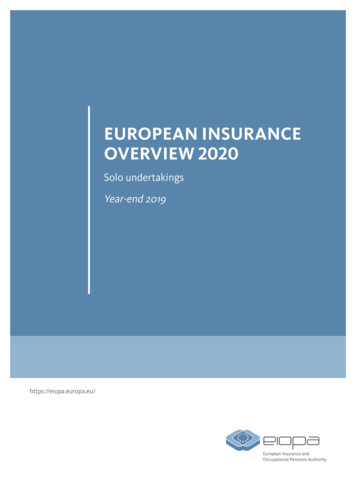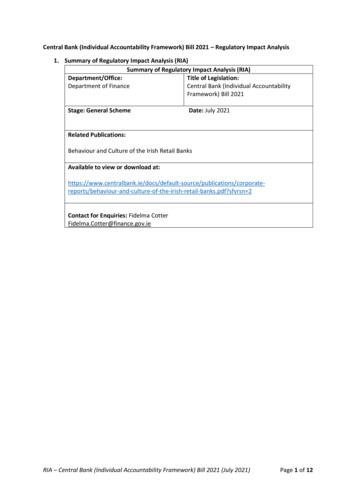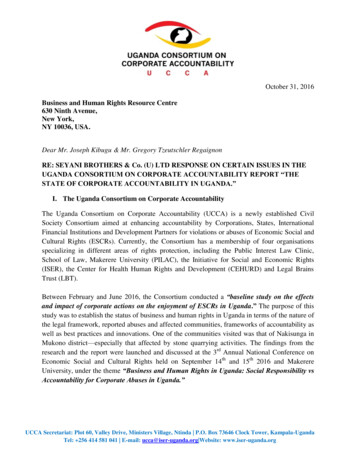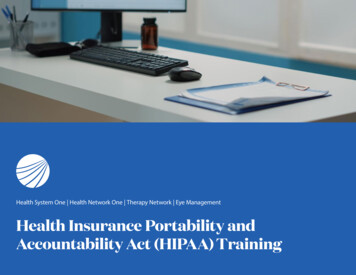
Transcription
Health System One Health Network One Therapy Network Eye ManagementHealth Insurance Portability andAccountability Act (HIPAA) TrainingHealth System One Health Network One Therapy Network Eye ManagementHIPAA Training — 2022FEB03 2037211
Health Insurance Portability & Accountability Act (HIPAA)Training on Privacy policies/procedures of:– Eye Management, LLC. (EM)– Health Network ONE, Inc. (HN1)– Health system one/HS1 Medical Management, Inc. (Hs1)– HN1 Therapy Network, LLC(HN1 TN)The companies listed above are referred to as “Affiliated Covered Entities” (ACE)Health System One Health Network One Therapy Network Eye ManagementHIPAA Training — 2022FEB03 2037212
What is HIPAA?– HIPAA is the acronym for the Health Insurance Portability & Accountability Act of1996.– It is a law that provides protection standards for patient confidentiality and its healthinformation. It also provides security standards for electronic systems and for thetransmission of health information in electronic format.HIPAA’s Title II aims for “Administrative Simplification” of the health insurance system inthree ways:– Electronic data sent from a doctor or hospital to an insurance payer, or delegatedrepresentative must be in approved electronic format– Data systems must be secure, so information will not get into the wrong hands– People who handle patient health information must protect the privacy and rights ofthe patients.Health System One Health Network One Therapy Network Eye ManagementHIPAA Training — 2022FEB03 2037213
Who is covered by HIPAA?– Health Plans– Healthcare Providers and Institutions: physicians, hospitals– Health care Clearinghouses: central institutions that establish transactions.– HIPAA requires that covered entities use or disclose PHI in a limited way.Under the HIPAA minimum necessary standard, HIPAA-covered entities are requiredto make reasonable efforts to ensure that access to PHI is limited to the minimumnecessary information to accomplish the intended purpose of a particular use,disclosure, or request.Health System One Health Network One Therapy Network Eye ManagementHIPAA Training — 2022FEB03 2037214
Protected Health Information (PHI):– PHI is individually identifiable health information collected from an individual, createdor received by a covered entity ANDy Is related to the past, present, or future physical or mental health or condition of anindividual; the provision of health care to an individual; or to the past, present, orfuture payment for the provision of health care to an individual; ANDy That identifies the individual or could identify the individual.y That could be transmitted or maintained electronically, or through any othermedium.– Protected health information (PHI) has two components:y Health information AND Information about a specific, identifiable person– There are rules about how PHI may be used so it is important to know whatthey are and apply them consistently!Health System One Health Network One Therapy Network Eye ManagementHIPAA Training — 2022FEB03 2037215
Examples of an Individual’s Identifiers:– Remember, PHI only applies to Individually Identifiable Health Information; bothcomponents must be present.– Information that can be used to identify, contact, or locate an individual.NamesGeographic dataAll elements of datesTelephone numberFax NumbersEmail addressSocial Security NumberMedical record numbersHealth plan beneficiarynumbersy Account numbersyyyyyyyyyHealth Informationy Certificate/licensenumbersy Vehicle identifiers andserial numbers includinglicense platesy Device identifiers andserial numbersy Web URLs (UniformResource Locater)y Internet protocoladdressesPHI IdentifierHealth System One Health Network One Therapy Network Eye Managementy Biometric identifiers (e.g.retinal scan, fingerprints)y Full face photos andcomparable imagesy Any unique identifyingnumber, characteristic orcodePHIHIPAA Training — 2022FEB03 2037216
PHI Formats– PHI can exist in written, oral, or electronic format.– Examples of verbal PHI :y When we talk to doctors and office staff.y When we deal with pharmacies or insurance companies.y When we talk to patients themselves.y When we deal with inquiries from government officials.Health System One Health Network One Therapy Network Eye ManagementHIPAA Training — 2022FEB03 2037217
Examples of an Individual’s Health Information:– Information that describes a medical condition, such as a diagnosis or diagnosis code– Information that identifies a medical procedure or treatment, like a procedure code– A prescription– A medical chart– Vital signs or medical test results– The record of a doctor’s appointment– A medical claim form– A patient’s eligibility information, membership in a health plan, or insuranceinformationHealth System One Health Network One Therapy Network Eye ManagementHIPAA Training — 2022FEB03 2037218
PHI Safeguards– The improper use or disclosure of sensitive information presents the risk of identifytheft, invasion of privacy, and can cause harm.– Breaches can also result in criminal and civil penalties for both the ACE and thoseindividuals who improperly access or disclose sensitive information.We must safeguard all patients’ PHI whether it is in written, electronic, or oral form.The following pages cover some of the methods that we should use to safeguard PHI,including these:– Oral, Telephone and Voice Mail Safeguards– Mail Safeguards– Fax Safeguards– Computer Safeguards– E-Mail SafeguardsHealth System One Health Network One Therapy Network Eye ManagementHIPAA Training — 2022FEB03 2037219
PHI Safeguards (continued)Oral, Telephone/Voice-mail safeguards:– Do not talk about an individual’s PHI in public areas within the workplace, suchreception area or break room, or outside of the workplace.– Do not play back voice mail messages with the speakerphone button on.Mail Safeguards:– Make sure that open mail containing PHI is not left sitting in a public area.Fax Safeguards:– Always use a cover sheet that includes a confidentiality statement.– Double-check the fax number you are sending the information to.– Whenever possible, use a fax directory or call the recipient immediately before andafter sending the fax, to ensure that it is expected, and is picked up promptly.Health System One Health Network One Therapy Network Eye ManagementHIPAA Training — 2022FEB03 20372110
PHI Safeguards (continued)E-Mail Safeguards:– Emails containing PHI must be sent secured and encrypted.– As an information security measure, do not use your personal emails to receive orshare the confidential and protected health information of our members.– Please follow the guidelines below when sending PHI via email:y Include the minimum necessary of PHI to complete the purpose of the message.y Ensure that the address of the recipient is correct and that the document includedin the message (if any) is correct.y Encrypt all emails to external persons outside the company.y Do not send PHI in email unless email is encrypted.y Never put any PHI in the subject line of emails.Health System One Health Network One Therapy Network Eye ManagementHIPAA Training — 2022FEB03 20372111
PHI Safeguards (continued)Computer Safeguards: Password Management– Create a unique, strong password or PIN for each account or device and keep yourcredentials secure.y Don’t use personal or easy-to-guess information when creating a password.y Make a password complex by adding numbers, multi-case letters (upper and lower),and symbols.y Mix numbers into the center of your password.– Password Policy Guidelines:y A minimum of 8 characters long and contain at least a mix of THREE of thefollowing FOUR properties: Lowercase letters (a-z) Uppercase letters (A-Z) Numbers (0-9) Symbols (!” % &*)– Strong password example: B5rCo5#44E4, M1c3nm3n, Goo*stovHealth System One Health Network One Therapy Network Eye ManagementHIPAA Training — 2022FEB03 20372112
PHI Safeguards (continued)Password Management Don’t:– Reveal your password to anyone.– Share your password to your supervisor, Service Desk employee, or a family member.– Allow anyone else to use your User ID and password.– Reveal your password on questionnaires or security forms.– Store your passwords in a file on any computer system.– Re-use the same password– Write your passwords down and store them anywhere in your office.– Place your passwords into email messages or other forms of electroniccommunication.Remember: Change all passwords frequently and keep your passwordssecret.Health System One Health Network One Therapy Network Eye ManagementHIPAA Training — 2022FEB03 20372113
Privacy RulePurpose:– Protects the confidentiality of PHI in all formats (paper, verbal, and electronic).– Grants the members understanding and control of how their PHI is used.– Ensures that PHI is used for health purposes only.– Establishes that PHI can only be disclosed for treatment, payment, or health careoperations (TPO) or with the consent (valid authorization) of the individual.– Establishes individual’s rights with respect to their health information.– Establishes the notification process for HIPAA Breaches.Health System One Health Network One Therapy Network Eye ManagementHIPAA Training — 2022FEB03 20372114
What does the Privacy Rule requireproviders and health plans to do?– Notify the individuals about their privacy rights and how their information can beused and disclosed.– Adopt and implement processes in their practices, hospitals, or plan.– Train their employees to understand the privacy processes.– Designate a responsible person to ensure that the privacy processes are applied andfollowed.– Ensure that the records containing PHI are not exposed or available for use byunauthorized persons.Health System One Health Network One Therapy Network Eye ManagementHIPAA Training — 2022FEB03 20372115
Permitted Uses and Disclosures of PHI45 CFR 164.502The use and disclosure of PHI is permissible:– For TPO: treatment, payments and healthcare operations.– When a valid written authorization exists from the individual, authorizingthe use and disclosure of his/her PHI to a third party (representative).– To a family member or friend that is involved with the medical care or payment of themedical care of the individual and the individual has the opportunity to accept/objectthe use or disclosure.– For health oversight activities.– When it is required by law.– For law Enforcement Purposes or National Security.– For judicial and administrative proceedings.– For Forensic Pathologist, Judges and Funeral Directors.– To avert a serious threat to health or safety .– Among others.Health System One Health Network One Therapy Network Eye ManagementHIPAA Training — 2022FEB03 20372116
Accounting for Disclosure– We must be able to tell patients if their PHI is given to other parties.– We are not required to account for disclosures if the patient authorized the disclosure.– The Office of the Privacy Official handles all these requests.Health InformationManagementBusiness equestingOrganizationsAttorneys, Audits,DDS, Govt.Agencies, InsuranceCompanies, RecordRetrieval Services,Communication ofCare Patients, etc.Other Misc.Health System One Health Network One Therapy Network Eye ManagementHIPAA Training — 2022FEB03 20372117
Reporting Privacy or Security ConcernsThe following require immediate notification to the HIPAA Team at:HIPAA@healthsystemone.com– Sensitive, confidential or proprietary information (excluding PHI) is lost, disclosed tounauthorized parties, or suspected of being lost or disclosed to unauthorized parties.– Unauthorized use of the ACE’ information system has taken place, or is suspected oftaking place.– Passwords or other system access control mechanisms are lost, stolen, or disclosed, orare suspected of being lost, stolen, or disclosed.– Any and all unusual systems behavior, such as missing files, frequent system crashes,misrouted messages, and the like which may be indicative of a computer virusinfection or similar security problem.Unintended use or disclosure of PHI or any HIPAA breach must be reported as soon as itis known to the email address above.Health System One Health Network One Therapy Network Eye ManagementHIPAA Training — 2022FEB03 20372118
Privacy Breach Assessment– The use or disclosure not authorized of PHI for HIPAA is presumed to be a breachunless the covered entity or business associate demonstrates that there is a lowprobability that the PHI has been compromised.– Risk Analysis to determine if the PHI was compromised can include:y The nature and extent of the PHI involved, including the types of identifiers and thelikelihood of re-identification.y The unauthorized person who used the PHI or to whom the disclosure was made.y Whether the PHI was actually acquired or viewed.y The extent to which the risk to the PHI has been mitigated.Health System One Health Network One Therapy Network Eye ManagementHIPAA Training — 2022FEB03 20372119
Examples of PHI Breach– Unauthorized disclosure of PHI to a third party in paper or electronically (without avalid authorization).– Lost, stolen or improper disposition of documents with PHI.– Access to PHI when its not required for job duties.– Access of PHI for an improper purpose by an unauthorized person.– Send unprotected PHI outside the company (e.g. without encryption) and anunauthorized person has access to the information.– Discuss PHI (such medical results, diagnosis and conditions) with the individual inpublic areas, where others can hear the conversation.– Disclose PHI in a manner not permitted by HIPAA.Health System One Health Network One Therapy Network Eye ManagementHIPAA Training — 2022FEB03 20372120
Treatment, Payment and OperationsHIPAA allows the office to do routine things with PHI. These routine things aresummarized with the terms “Treatment, Payment and Operations” (TPO).Treatment: All that is done as part of a patient’s medical care, such as:– Health care appointments– Lab testing– Filling a prescription at the drug store– Referring a patient to a counselor or specialist– Reminding a patient about health care or appointments– Participating in the prior approval process with doctors and hospitals to determinethe appropriate treatment for a patient.Health System One Health Network One Therapy Network Eye ManagementHIPAA Training — 2022FEB03 20372121
Treatment, Payment and Operations (continued)Payment: All the activities related to paying for a person’s health care, suchas:– Determining if an individual is eligible for a program– Coordinating claims with other payers– Reviewing medical records to decide if a procedure should be paid– Verifying insurance eligibility or coverage limits– Discussing claims with providers in person, by correspondence, or on the phone– Sending a remittance document to providers identifying the patients and proceduresthat are being paid and denied.Health System One Health Network One Therapy Network Eye ManagementHIPAA Training — 2022FEB03 20372122
Treatment, Payment and Operations (continued)Operations: All the activities done to operate divisions that may providehealth care services, such as:– Auditing– Rate-setting for contracted providers– Policy determination for programs– Fraud and abuse detection– Employee training– Legal services– Contract provider assignment activitiesHealth System One Health Network One Therapy Network Eye ManagementHIPAA Training — 2022FEB03 20372123
Patient Authorization:We must have written authorization from the patient, or the patient’spersonal representative, before we can use or disclose PHI for any purpose, withthese exceptions:– Treatment, Payment, and Health Care Operations, or– As permitted or required by law without authorizationPsychotherapy notes and HIV/AIDS-related data are especially sensitive.DO NOT RELEASE them without notifying the Privacy Official.Health System One Health Network One Therapy Network Eye ManagementHIPAA Training — 2022FEB03 20372124
Individual’s Rights under HIPAA– Right of Access: The Privacy Rule required Covered Entities (e.g. health plans) toprovide individuals, upon request, the right to inspect or obtain a copy of their PHI inone or more “designated record sets” maintained by or for the covered entity. (45 CFR164.524)y A covered entity must act on a request for access no later than 30 days after receiptof the request. An extension of 30 days can be made notifying the individualmaking the request.y The plan can send a copy of the PHI directly to a third person designated by theindividual, if such request is made in writing, providing the name and address ofthe third party.– Right to Amend or Correct PHI: Individuals have the right to have coveredentities amend their PHI in a designated record set when that information isinaccurate or incomplete. (45 CFR 164.526)y Covered entities must respond to a request for an amendment within 60 days.Health System One Health Network One Therapy Network Eye ManagementHIPAA Training — 2022FEB03 20372125
Individual’s Rights under HIPAA (continued)– Right to Disclosures of Accounting of PHI: Individuals have a right to an accountingof the disclosures of their PHI by a covered entity or the covered entity’s businessassociates except the disclosures made for one the following reasons:y Treatment, payment, or healthcare operations (TPO), pursuant to a validauthorization, to the subject of the information, for national security purposes, tocorrectional institutions or law enforcement officials for certain purposes regardinginmates or individuals in lawful custody, incident to otherwise permitted orrequired uses or disclosures. (45 CFR 164.528)y Request of an accounting of disclosures of PHI must be acted on no later than 60days after receipt of the request. An extension of 30 days can be made notifying theindividual making the request.Health System One Health Network One Therapy Network Eye ManagementHIPAA Training — 2022FEB03 20372126
Individual’s Rights under HIPAA (continued)– Request of Restrictions: Individuals have the right to request that a covered entityrestrict uses or disclosures of PHI for treatment, payment or health care operations(TPO), disclosures to persons involved in the individual’s health care or payment forhealth care, or disclosures to notify family members or others about the individual’sgeneral condition, location, or death. (45 CFR 164.522 (a)).y The plan is under no obligation to agree to requests for restrictions. However, ifthe plan does agree, it must comply with the agreed upon restrictions, except forpurposes of treating the individual in a medical emergency and the restricted PHI isneeded to provide the emergency treatment.– Confidential Communications: The plan must permit members to request analternative means or location for receiving communications of PHI by means otherthan those that the plan typically employs. (45 CFR 164.522 (B))y For example: A member can request that the health plan communicate with theindividual through a designated address or phone number.– Health Plans must accommodate reasonable requests if the individual indicates thatthe disclosure of all or part of the PHI could endanger the individual.Health System One Health Network One Therapy Network Eye ManagementHIPAA Training — 2022FEB03 20372127
Releasing a minor’s PHI to a parent– One of the permitted releases without authorization applies to releasing the PHI of aminor child to their parent(s).– You can answer a parent’s questions about his/her minor (age 17 and under) childwithout requiring a written consent. However, as in all situations, be helpful butprovide only the information that is requested, and nothing more.Health System One Health Network One Therapy Network Eye ManagementHIPAA Training — 2022FEB03 20372128
PHI of a Deceased Individual– The Final Rule limits the period of protection of PHI of a deceased individualto 50 years. This is a protection term, not a record retention period.– The Final Rule also allows the disclosure of PHI of a deceased individual toa family member or close friend who was involved in the individual’s careor payment of healthcare prior to the individual’s death, unless doing so isinconsistent with any prior expressed preferences of the individual.Health System One Health Network One Therapy Network Eye ManagementHIPAA Training — 2022FEB03 20372129
Minimum Necessary Rule:HIPAA requires that when you use or disclose PHI, you must follow the “MinimumNecessary Requirement”. This means that you must use or disclose only theinformation requested or needed. Applies to all forms of communication:paper, fax, oral, and electronic communication of PHI.– The minimum standard requirement does not apply to:y Disclosures to, or requests, by a health care provider for treatment purposes.y Disclosures to the individual who is the subject of the information.y Uses or disclosures made pursuant to an individual’s authorization.y De-identified information.y Uses or disclosures required by law.y Among others.Health System One Health Network One Therapy Network Eye ManagementHIPAA Training — 2022FEB03 20372130
Additional requirements for privacy– Substance Abuse Information– Mental Health related data– HIV-AIDS related informationRequirements for confidentiality of substance abuse related information have been inplace since the early 1970’s. The principles established then were expanded to includeall identifiable heath information with the enactment of HIPAA.Currently, these three categories of PHI are emphasized in the Privacy practices that arerecommended for all covered entities because these health issues may carry additionalsocial repercussions to an individual.Health System One Health Network One Therapy Network Eye ManagementHIPAA Training — 2022FEB03 20372131
Penalties for non-complianceAs covered entities, we are required to sanction members of our workforce (employee,contractor, etc.) and business associates, up to termination.– There are legal penalties — fines and even jail time —for people whoviolate HIPAA rules.y Civil penalties imposed by the Office of Civil Rightsy Criminal penalties imposed by the Department of Justice These penalties apply to managers and the company in general if we fail toestablish policies and provide training to staff. The penalties apply to staff if you ignore the law, especially if you deliberatelygive someone’s private information to another person that is not supposed tosee it.Health System One Health Network One Therapy Network Eye ManagementHIPAA Training — 2022FEB03 20372132
Remember: Management of PHI– Follow the procedure for the proper disposal of sensitive information using lockedrecycling drop boxes.– Keep laptops, smartphones, USBs and any other memory or document containing PHIin a secure place.– Never leave PHI on your desk in plain sight.– Make sure not to leave documents that contain PHI in printers or fax machines.– Use strong passwords. Keep your user ID and passwords confidential and secure.Never share your password sor user name (User ID).– Do not access PHI that you do not need to access.Health System One Health Network One Therapy Network Eye ManagementHIPAA Training — 2022FEB03 20372133
Wrap-up! HIPAA@healthsystemone.com– PHI & Sensitive information exists in many forms: printed, spoken, and electronic.– PHI & Sensitive information includes Social Security numbers, credit card numbers,driver’s license numbers, and computer passwords.– Two primary HIPAA regulations are the Privacy Rule and the Security Rule.– When used to identify a patient and when combined with health information,HIPAA identifiers create PHI.Health System One Health Network One Therapy Network Eye ManagementHIPAA Training — 2022FEB03 20372134
Report ethical, compliance,fraud, waste, andabuse violations in a confidential manner at:SIU@healthsystemone.com1-866-321-5550Health System One Health Network One Therapy Network Eye ManagementHIPAA Training — 2022FEB03 20372135
Health System One Health Network One Therapy Network Eye Management HIPAA Training — 2022FEB03_2037215 Protected Health Information (PHI): - PHI is individually identifiable health information collected from an individual, created or received by a covered entity AND y Is related to the past, present, or future physical or mental health or condition of an



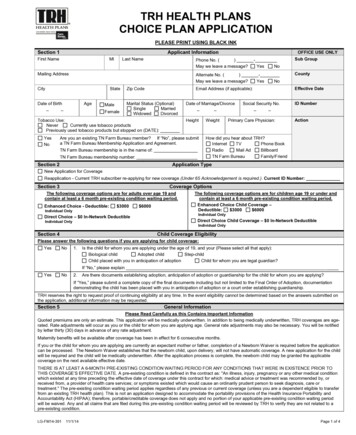
![[MS-DPSSAS]: SQL Server Analysis Services Data Portability Overview](/img/37/5bms-dpssas-5d.jpg)
![[MS-DPSSAS]: SQL Server Analysis Services Data Portability .](/img/15/5bms-dpssas-5d-140520.jpg)
